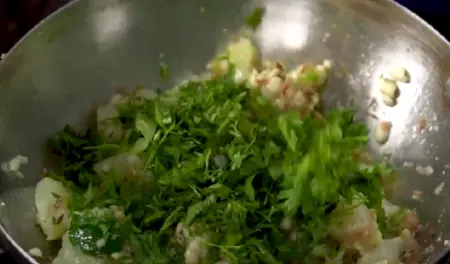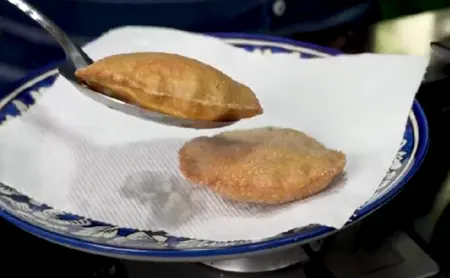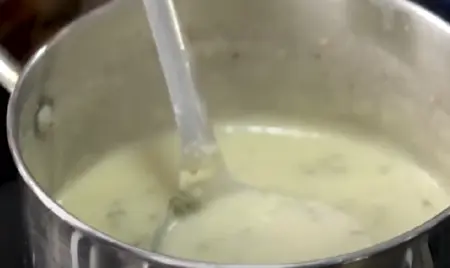
Gujarati Vrat Thali Recipe

30 mins

4-5 servings

20 mins
Introduction:
As a child, I vividly remember the excitement that filled our home during the festival of Navratri. It wasn't just about the vibrant dances and colorful attire but also about the delicious food, especially the Gujarati Vrat Thali. This traditional fasting meal holds a special place in my heart, not only for its delightful flavors but also for the sense of togetherness it brings to the family. The combination of wholesome ingredients, aromatic spices, and intricate flavors makes this dish a true culinary delight, one that I'm eager to share with you today.
Ingredients of Gujarati Vrat Thali
For Kadhi:
- 1 cup Dahi (yogurt)
- 2 tbsp Rajgira Atta (amaranth flour)
- 700 ml Water
- 1 tsp Salt
- 1 tbsp Oil
- 1 tsp Jeera (cumin seeds)
- 2 Green Chillies, diced
- 10 Curry Leaves
- 1 tsp Chopped Ginger
- 1 tbsp Chopped Coriander
For Sabzi:
- 4 tbsp Peanut Oil
- 1 tsp Jeera (cumin seeds)
- 2 Green Chillies, diced
- 1 sprig Curry Leaves
- 1 cup Peanuts, pounded
- 1 tsp Chopped Ginger
- 4 Potatoes, boiled and diced
- 1 tsp Salt
- 1 tsp Sugar
- 1 tbsp Lemon Juice
- 1 tbsp Chopped Coriander
For Poori:
- 2 cups Rajgira Atta (amaranth flour)
- ½ boiled Potato
- 1 tsp Salt
- 1 tsp Black Pepper Powder
- 1 tsp Ginger and Green Chilly, pounded
For Chutney:
- 1 tsp Ginger and Green Chilly, pounded
- 1 cup Peanuts, pounded
- 1 tsp Salt
- 1 tsp Sugar
- 2 tbsp Curd (yogurt)
Instructions of Gujarati Vrat Thali
For Kadhi:
-
Prepare the Kadhi Base:
Mix Rajgira Atta with Dahi and whisk them together until smooth. -
Boil and Simmer:
Add salt and 700 ml of water, then bring the mixture to a boil while stirring continuously. Once it reaches a boil, reduce to a simmer on low heat. -
Tadka for Kadhi:
In a separate pan, heat oil and crackle the cumin seeds. Add diced green chillies, curry leaves, and chopped ginger. Pour this tempering over the kadhi and let it simmer. -
Finish with Coriander:
Garnish the kadhi with freshly chopped coriander before serving.
For Sabzi:
-
Heat Oil and Crackle Jeera:
Heat peanut oil in a pan, and once hot, add jeera and allow it to crackle. -
Add Aromatics:
Add curry leaves, diced green chillies, and chopped ginger. Sauté until fragrant. -
Cook Potatoes:
Add the boiled and diced potatoes to the pan. Stir in salt, sugar, and the pounded peanuts. -
Finish with Lemon and Coriander:
Once the potatoes are well coated, turn off the heat and finish with a squeeze of lemon juice and a sprinkle of chopped coriander. -

For Poori:
-
Prepare the Dough:
Sieve the Rajgira Atta into a bowl. Add crumbled boiled potato, ginger and green chilly paste, black pepper, and salt. Mix well. -
Knead the Dough:
Gradually add water and knead into a tight dough. Divide the dough into equal portions and roll into small pooris. -
Fry the Pooris:
Heat oil in a deep pan and fry the pooris until they turn golden brown. Remove and drain on paper towels. -

For Chutney:
-
Mix the Ingredients:
In a bowl, mix pounded green chillies, ginger, salt, and sugar. -
Add Peanuts and Dahi:
Add pounded peanuts and dahi to the mixture. Stir until well combined, and the chutney is ready to serve. -

About the Recipe:
The Gujarati Vrat Thali is a traditional fasting meal commonly enjoyed during religious festivals such as Navratri. It consists of a variety of dishes prepared using ingredients that are permissible to consume during fasting periods according to Hindu dietary customs. The thali typically includes dishes like Sabudana Khichdi, Rajgira Paratha, Kuttu Ka Dosa, and Samak Rice, along with accompaniments like Peanut Chutney, Yogurt, and Fresh Fruits.
Cooking Tips:
- Use fasting-friendly ingredients: Ensure that all the ingredients used in the Gujarati Vrat Thali are permissible to consume during fasting periods, such as sabudana (tapioca pearls), rajgira (amaranth flour), kuttu (buckwheat flour), and samak (barnyard millet).
- Be mindful of spices: While preparing the dishes, use fasting-approved spices like rock salt (sendha namak), cumin seeds, ginger, green chilies, and fresh herbs to enhance the flavors without compromising the fasting guidelines.
- Experiment with flavors: Explore different combinations of ingredients and spices to create a diverse and flavorful thali that caters to your preferences.
- Pay attention to textures: Ensure a balance of textures in the thali by including dishes with varying consistencies, such as soft and fluffy sabudana khichdi, crispy rajgira paratha, and smooth peanut chutney.
- Keep it light: Since fasting meals are meant to be light on the stomach, avoid using excessive oil or frying techniques that may make the dishes heavy and difficult to digest.
- Garnish with love: Add a final touch of freshness and flavor to the thali by garnishing the dishes with freshly chopped cilantro, grated coconut, or a squeeze of lime juice before serving.
Pairing Guide:
The Gujarati Vrat Thali pairs well with a variety of accompaniments and beverages, including:
- Freshly squeezed fruit juices
- Buttermilk (chaas)
- Sweet lassi
- Coconut water
- Roasted makhana (fox nuts)
- Sliced fresh fruits like bananas, apples, and grapes
- Sabudana papad
Frequently Asked Questions (FAQs) about Gujarati Vrat Thali:
-
What is Gujarati Vrat Thali? Gujarati Vrat Thali is a traditional fasting meal consisting of dishes prepared using ingredients permissible to consume during religious fasting periods.
-
What are some common dishes in Gujarati Vrat Thali? Common dishes in Gujarati Vrat Thali include Sabudana Khichdi, Rajgira Paratha, Kuttu Ka Dosa, Samak Rice, Peanut Chutney, Yogurt, and Fresh Fruits.
-
What ingredients are used in Gujarati Vrat Thali? Ingredients commonly used in Gujarati Vrat Thali include sabudana (tapioca pearls), rajgira (amaranth flour), kuttu (buckwheat flour), samak (barnyard millet), rock salt (sendha namak), and fasting-approved spices.
-
Can Gujarati Vrat Thali be customized? Yes, Gujarati Vrat Thali can be customized according to individual preferences by including different dishes and variations of fasting-friendly ingredients.
-
Is Gujarati Vrat Thali suitable for people with dietary restrictions? Yes, Gujarati Vrat Thali is suitable for people following Hindu fasting customs and those with dietary restrictions that allow for consumption of fasting-friendly ingredients.
-
Can Gujarati Vrat Thali be enjoyed on non-fasting days? While Gujarati Vrat Thali is traditionally consumed during fasting periods, it can also be enjoyed on non-fasting days as a nutritious and flavorful meal.
-
Are there any specific rituals associated with Gujarati Vrat Thali? Gujarati Vrat Thali is often prepared and served with reverence and devotion during religious festivals and fasting periods, with prayers and rituals performed before consuming the meal.
-
What beverages pair well with Gujarati Vrat Thali? Beverages like freshly squeezed fruit juices, buttermilk (chaas), sweet lassi, and coconut water complement the flavors of Gujarati Vrat Thali.
-
Can Gujarati Vrat Thali be made in advance? Yes, many components of Gujarati Vrat Thali can be prepared in advance and stored refrigerated until ready to serve, making it convenient for busy days.
-
What makes Gujarati Vrat Thali unique? Gujarati Vrat Thali stands out for its use of fasting-approved ingredients, vibrant flavors, and wholesome yet light preparations that cater to both religious and dietary preferences.
